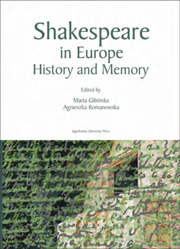Book contents
- Frontmatter
- Contents
- Preface
- Towards a European History of Henry V
- History and Histories
- History and Memory: Criticism and Reception
- History, Memory, and Ideological Appropriation
- Claiming Shakespeare as “Our Own”
- “Must i Remember?:” Hamlet, Memory and Shakespearean Trauma
- Interdisciplinary Shakespeare in the Socialist Republic of Romania. A Comment on Official Censorship and Subversive Practices
- Mingling and Separating in Coriolanus
- “A Goodly House:” Memory and Hosting in Coriolanus
- “Suit the Word to the Action:” Shakespeare's Richard II (2004). A Case of (Meta)Translation?
- “Speak, Memory:” Anniversary Celebrations in the History of the German Shakespeare Society
- Theatre: The Act of Memory and History in the Making
- Index of Authors
Claiming Shakespeare as “Our Own”
from History, Memory, and Ideological Appropriation
Published online by Cambridge University Press: 05 September 2014
- Frontmatter
- Contents
- Preface
- Towards a European History of Henry V
- History and Histories
- History and Memory: Criticism and Reception
- History, Memory, and Ideological Appropriation
- Claiming Shakespeare as “Our Own”
- “Must i Remember?:” Hamlet, Memory and Shakespearean Trauma
- Interdisciplinary Shakespeare in the Socialist Republic of Romania. A Comment on Official Censorship and Subversive Practices
- Mingling and Separating in Coriolanus
- “A Goodly House:” Memory and Hosting in Coriolanus
- “Suit the Word to the Action:” Shakespeare's Richard II (2004). A Case of (Meta)Translation?
- “Speak, Memory:” Anniversary Celebrations in the History of the German Shakespeare Society
- Theatre: The Act of Memory and History in the Making
- Index of Authors
Summary
Whose is Shakespeare, who has a right to claim Shakespeare and his exemplary text, Hamlet? This may seem an idle question, yet the long history of the appropriation of Shakespeare, and particularly Hamlet, suggests that for some Shakespeare functions as a status symbol and a locus of proprietary rights. As Alexander Shurbanov and Boika Sokolova remind us, there are “multiple claims on the Bard's heritage:” Shakespeare and Hamlet have been commandeered by a number of different communities. Within the scope of this essay I will be more concerned with the “how” than with the “why” of the process of claiming Shakespeare as “our own.”
In a literal sense, appropriation, following the Latin adjective proprius, refers to making something “one's own.” Shakespearean appropriation can be examined both in its diachronicity and synchronicity (or on a vertical and a horizontal level, if you will). A diachronic overview would survey how Shakespeare has been appropriated at different historical times (for example, the Shakespeares of the Restoration, the Enlightenment, Romanticism, postmodernism), whereas a synchronic perspective would demonstrate the specific ways and areas in which this appropriation takes place (for instance, genres, art forms, different ethnic communities and ideologies “recruiting” Shakespeare). For example, there are Shakespearean romances (among others, Erika Jong's 1986 novel Serenissima) and Shakespearean detective stories (for instance, Michael Innes's 1937 novel Hamlet, Revenge! and so on).
- Type
- Chapter
- Information
- Shakespeare in EuropeHistory and Memory, pp. 177 - 186Publisher: Jagiellonian University PressPrint publication year: 2008



